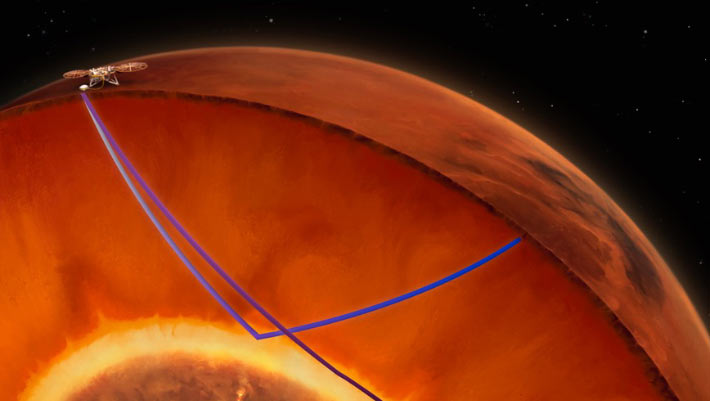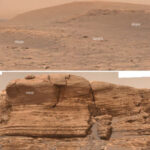Mars’ liquid iron alloy core is surrounded by a layer of fully molten silicate (magma) about 150 km thick, according to a pair of papers published in the journal Nature.
An artist’s depiction of a liquid silicate layer wrapped around the Martian core. Image credit: IPGP-CNES.
In 2021, an analysis of seismic data gathered by the Seismic Experiment for Interior Structure (SEIS) instrument onboard NASA’s InSight lander suggested the presence of a large but low-density core, composed of liquid iron and lighter elements such as sulfur, carbon, oxygen and hydrogen.
However, these results suggest that the core has a higher proportion of lighter elements than is feasible according to estimates of the abundances of these elements early in Mars’ formation history.
In the two new studies, the authors analyzed the latest batch of seismic data from InSight in combination with first principles simulations and geophysical models to produce their estimates for the size and composition of the Martian core.
They found that the liquid iron core of Mars is surrounded by an approximately 150 km-thick layer of near-molten silicate rock, the top of which was previously misinterpreted as the surface of the core.
This decrease in core radius implies a higher density than estimated in the earlier InSight study.
“The blanket not only insulates the heat coming from the core and prevents the core from cooling, but also concentrates radioactive elements whose decay generates heat,” said University of Maryland’s Professor Vedran Lekic.
“And when that happens, the core is likely to be unable to produce the convective motions that would create a magnetic field — which can explain why Mars currently doesn’t have an active magnetic field around it.”
Without a functional protective magnetic field around itself, a terrestrial planet such as Mars would be extremely vulnerable to harsh solar winds and lose all the water on its surface, making it incapable of sustaining life.
“This difference between Earth and Mars could be attributed to differences in internal structure and the different planetary evolution paths the two planets took,” Professor Lekic said.
“The thermal blanketing of Mars’ metallic core by the liquid layer at the base of the mantle implies that external sources are necessary to generate the magnetic field recorded in the Martian crust during the first 500 to 800 million years of its evolution,” said Dr. Henri Samuel of the French National Center for Scientific Research.
“These sources could be energetic impacts or core motion generated by gravitational interactions with ancient satellites which have since then disappeared.”
The findings support theories that Mars was at one time a molten ocean of magma that later crystallized to produce a layer of silicate melt enriched in iron and radioactive elements at the base of the Martian mantle.
The heat emanating from the radioactive elements would then have dramatically altered the thermal evolution and cooling history of the Red Planet.
“These layers, if widespread, can have pretty big consequences for the rest of the planet,” Professor Lekic said.
“Their existence can help tell us whether magnetic fields can be generated and maintained, how planets cool over time, and also how the dynamics of their interiors change over time.”
“The discovery of this stratification in the Martian mantle opens new research horizons, since the seismic data recorded by the SEIS instrument of the InSight mission will now be reconsidered in the light of this new paradigm,” said ISAE-SUPAERO’s Dr. Mélanie Drilleau.
_____
A. Khan et al. 2023. Evidence for a liquid silicate layer atop the Martian core. Nature 622, 718-723; doi: 10.1038/s41586-023-06586-4
H. Samuel et al. 2023. Geophysical evidence for an enriched molten silicate layer above Mars’s core. Nature 622, 712-717; doi: 10.1038/s41586-023-06601-8




